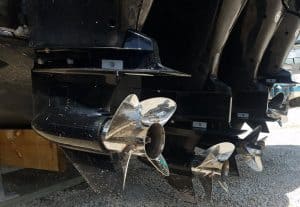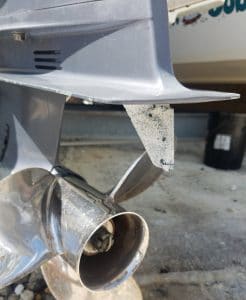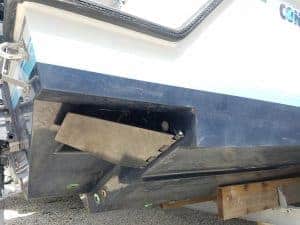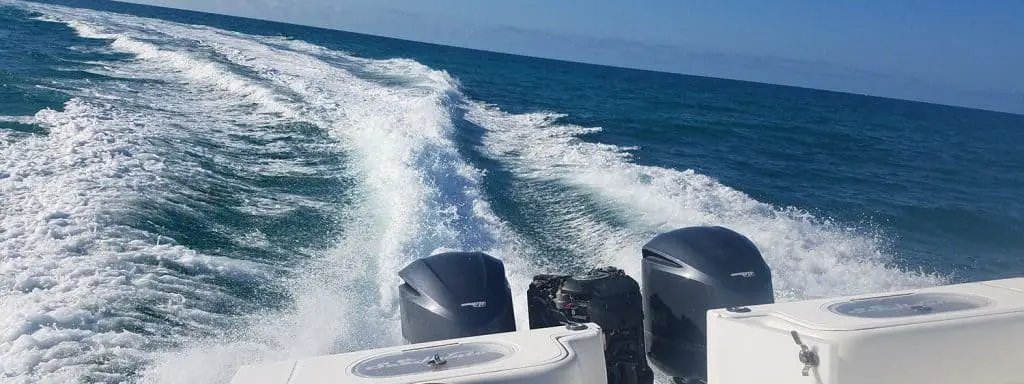Have you ever been on a smaller boat and let go of the steering wheel, just to have the whole boat start turning to the right or the left? It can be terrifying and extremely dangerous, leaving you wondering.
Why Does A Boat Pull To The Right Or The Left? A boat is driven by a propeller that spins in a clockwise or counterclockwise motion. Depending on the steering system of the boat, the force of the propeller pushing through the water can twist the engine to one side or the other and in turn, pulling the boat to the right or the left.
There are many things that can cause this, and many ways to fix or compensate for it. Here is everything that you need to know to fix the issue!
Why The Boat Pulls To The Right Or Left
There are a couple of reasons why boats will veer off in one direction or the other. That is mainly because of how the boat is pushed through the water by the propeller.
The boat’s engine drives the propeller that spins in either a clockwise direction, (standard rotation) or a counter-clockwise direction, (left-hand rotation or counter-rotation).
We give a really in-depth break down of the engine and how the mechanics of the engine spins the propeller in our article here about The Different Sections of An Outboard Engine. For more information on how the propeller is driven.
It is the force of the propeller that creates almost a twisting through the water that will drive the boat either to the right or the left.
In some instances, certain hull manufactures have this issue, just in the way the hull performs in the water. Probably one of the worst hulls that have an issue like this is a Century.
The 32′ Century being the worst! This hull, for whatever reason, will randomly go from cutting through the water on the keel to rolling over to one side and riding on one side of the boat’s hull between the gunwale and the keel!
For the unexpected, this can be extremely scary because the boat will just slam over to one side and then continue riding there and veering off to the side!
Twin, Triple, and Quad Engine Boats Pulling To One Side?
This can also happen to multiple engine boats as well. If the tie bar is not set up properly.
It’s pretty rare to have a triple or quad engine boat pull to one side, simply because of the power of the engines.
The twin-engine boat, on the other hand, can definitely do this if the tie bar is improperly set up. Tie bars are set up to have a certain amount of “tow-in” angle to them.
When driving the boat, you want the two wakes coming from the engines to cross each other anywhere from 25-50 feet from the back of the boat. This is adjusted by measuring the distance between the propellers.
Then the distance between the bolts mounting the tie bar to the engines. If the prop shafts are 26-inches apart, we want the tie bar to be around 26 1/4-inches to bring that wake in just a little.
This will affect how the boat moves through the water!
How The Engine Mounting Relates To The Issue
Another reason why this happens is if an engine is not mounted properly, but this is one of the least common issues for a boat leaning to one side or the other.
If the engine is a little crooked and off to one side of the keel, it can also push the boat to one side or the other.
This is rare, mainly because it is only corrected by remounting the engine. Meaning that the engine mounting bolt holes in the transom need to be filled in and then redrilled.
There are a few techniques to mounting the engine and finding the center of the transom. But it is crucial that the engine is centered on the keel of the boat.
Otherwise, it can cause the boat to pull really hard to one side or the other. This is a rare issue, though.
Most commonly, it has to do with the force of the propeller and then the steering system of the boat.
How The Steering System Relates To The Issue
The boat’s steering system is a key component of this issue. Mainly because most of the time we see this issue, it’s on a smaller boat, with a single-engine.
Having hydraulic steering will help alleviate this issue. Because the hydraulic steering doesn’t allow the engine to turn very much, and you are only going to be fighting the spin of the prop. Instead of the engine turning.
Whenever you are driving, and you take your hand off of the wheel. The force of that propeller is going to try and turn the engine in the direction it is spinning. Hydraulic steering holds the engine in place and doesn’t allow that to happen.
Whereas mechanical steering, the engine will spin that wheel and allow the engine to be turned to one side by the propeller. There are two different kinds of mechanical steering systems.
You have Rotary and Rack and Pinion steering. If you would like to know more about the differences, we wrote all about that here in our article about Rack & Pinion Vs. Rotary Boat Steering Systems.
There are “newer” mechanical systems out that use what is called “NFB” or No-Feedback systems. These mechanical steering systems have a built-in feature that helps combat this pulling issue and keeps the helm from turning over. Holding the engine in place!
Understanding How The Propeller Relates
 We keep talking about the force and twist of the propeller. So we should talk a little bit about how exactly that is and what does more than others.
We keep talking about the force and twist of the propeller. So we should talk a little bit about how exactly that is and what does more than others.
The most common propellers are three blade and four-blade props. You probably won’t see a five-blade prop on a smaller, single-engine boat. Depending on where you live ;)
The blades on the prop play a major role in this pulling issue. The more blades in the water, the more force you get. You have more contact with the water and can force more water than with only three blades.
So if you have a four-blade prop, the pull will be harder because you have more torque with that four-blade prop.
The pitch will also affect this, as well. The pitch is the theoretical distance that the propeller will move through the water in one revolution.
So a 20 pitch prop will theoretically move 20-inches through the water when it spins all the way around one time.
Which means that the larger the pitch, the more torque or force that prop is going to have in the water, to turn the boat to the left or the right.
Compensating With The Anti-Ventilation Plate Trim Tab
 Now there are a couple of ways to compensate for this. One of those ways is with the anti-ventilation plate trim tab. If your engine has one. Most of the smaller engines do, and this can help to take away that pull.
Now there are a couple of ways to compensate for this. One of those ways is with the anti-ventilation plate trim tab. If your engine has one. Most of the smaller engines do, and this can help to take away that pull.
This is located directly above the propeller on the anti-ventilation plate. We can adjust this tab to the left or the right and help counter the turn of the engine.
There is a bolt holding it on, Yamaha’s usually have a 12mm bolt and Mercury’s use a 1/2-inch bolt.
We want to adjust the tab in the direction that the boat is pulling, to help compensate.
So, if your boat is pulling to the right, then we want to spin the trim tab to the right.
This will create a little force against the engine, pushing it in the opposite direction that the prop is trying to turn the engine.
The same thing for the left, if the boat is turning to the left, we want to turn the tab to the left.
We can play with the adjustment some as well. We just loosen the bolt and move the tab over. Then if it doesn’t change anything, we can move it farther over, or if it is too much, we’ll just move it back a little bit.
Compensating With Trim Tabs
 Now, it’s important not to confuse an engine anti-ventilation plate trim tab with boat trim tabs.
Now, it’s important not to confuse an engine anti-ventilation plate trim tab with boat trim tabs.
Trim tabs can be installed onto a boat to help compensate for pulling or different seas.
These are less common on lake boats because they are mainly used in offshore boats. That has to deal with current and wind conditions that have a major force to move the boat around.
Boat trim tabs are planes that are mounted on the stern of the boat. One on each corner of the hull.
These can be lowered a certain amount into the water to push the boat to the left or the right. As the plane comes down and meets the water, it will create a lifting force on the hull, driving the hull in the opposite direction.
So, if you put the starboard trim tab down, it will push the boat to the left, or port. Then vice versa for the port trim tab.
These will also give the boat some more lift when coming out of the water. To get a better hole shot.
Trim tabs are great and extremely helpful for compensating for a boat that wants to pull to one side or the other!
If you would like to learn more about trim tabs. Check out this article here that we have written Going Into The Details Of The Differences Between Trim Tabs & Tilt and Trim!
Check Us Out!
Thank you for stopping by, and hopefully, this has cleared up the confusion of why your boat is pulling to the right or the left!
If you’ve got any questions or comments, let us know by subscribing to our YouTube Channel!
And if you would like to support us to continue bringing you great content, please click the link below to Amazon where we get a commission from anything you are already going to buy!
And you can also donate by clicking the donate button here or on the right hand of the screen!
It really helps us out and we thank you so much for your support!
Something else that you might find interesting is what we have to say about Whether A Boat is A Good or Bad Investment! We also have great information on the differences between Inboards and Outboards!
Then if you are used to freshwater and have never seen the effects of saltwater on a boat. We think you will really enjoy this article about Moving A Boat From Freshwater To Saltwater & What You Need To Know!
We also have a ton of videos on our Youtube Channel: Born Again Boating! Where we cover all kinds of how-to tutorials. As well as DIY and outboard service videos! We hope you’ll check us out, get subscribed to the channel.
Then add our website to your favorites so we can become your go-to resource. For when it comes to completing all of your boating DIY projects!

